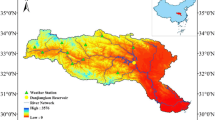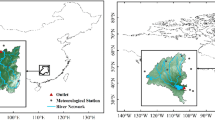Abstract
Linking atmospheric and hydrological models is challenging because of a mismatch of spatial and temporal resolutions in which the models operate: dynamic hydrological models need input at relatively fine temporal (daily) scale, but the outputs from general circulation models are usually not realistic at the same scale, even though fine scale outputs are available. Temporal dimension downscaling methods called disaggregation are designed to produce finer temporal-scale data from reliable larger temporal-scale data. Here, we investigate a hybrid stochastic weather-generation method to simulate a high-frequency (daily) precipitation sequence based on lower frequency (monthly) amounts. To deal with many small precipitation amounts and capture large amounts, we divide the precipitation amounts on rainy days (with non-zero precipitation amounts) into two states (named moist and wet states, respectively) by a pre-defined threshold and propose a multi-state Markov chain model for the occurrences of different states (also including non-rain days called dry state). The truncated Gamma and censored extended Burr XII distributions are then employed to model the precipitation amounts in the moist and wet states, respectively. This approach avoids the need to deal with discontinuity in the distribution, and ensures that the states (dry, moist and wet) and corresponding amounts in rainy days are well matched. The method also considers seasonality by constructing individual models for different months, and monthly variation by incorporating the low-frequency amounts as a model predictor. The proposed method is compared with existing models using typical catchment data in Australia with different climate conditions (non-seasonal rainfall, summer rainfall and winter rainfall patterns) and demonstrates better performances under several evaluation criteria which are important in hydrological studies.











Similar content being viewed by others
References
Agresti A (1990) Categorical data analysis. Wiley, New York
Akaike H (1974) A new look at the statistical model identification. IEEE Trans Automat Control AC-19:716–723
Allard D, Bourotte A (2015) Disaggregating daily precipitations into hourly values with a transformed censored latent Gaussian process. Stoch Environ Res Risk Assess 29:453–462
Chapman DG (1956) Estimating the parameters of a truncated gamma distribution. Annu Math Stat 27(2):498–506
Cramér H (1928) On the composition of elementary errors (second paper: statistical Applications). Skandinavisk Aktuarietidskrift 11:141–180
Cunnane C (1978) Unbiased plotting position—a review. J Hydrol 37:205–222
Di Fonzo T (2003) Temporal disaggregation of economic time series: towards a dynamic extension. Working papers and studies, European Communities, Luxembourg: Office for Official Publications of the European Communities
Furrer EM, Katz RW (2007) Improving the simulation of extreme precipitation events by stochastic weather generators. Clim Res 34:129–144
Furrer EM, Katz RW (2008) Generalized linear modeling approach to stochastic weather generators. Water Resour Res 44:W12439. doi:10.1029/2008WR007316
Gargouri-Ellouze E, Chebchoub A (2008) Modélisation de la structure de dependence hauteur-durée d’événements pluvieux par la couple de Gumbel. Hydrol Sci J 53(4):802–817
Guenni L, Bárdossy A (2002) A two steps disaggregation method for highlyseasonal monthly rainfall. Stoch Environ Res Risk Assess 16:188–206
Jones DA, Wang W, Fawcett R (2009) High-quality spatial climate data-sets for Australia. Aust Meteorol Oceanogr J 58:233–248
Koutsoyiannis D, Manetas A (1996) Simple disaggregation by accurate adjusting procedures. Water Resour Res 32(7):2105–2117
Koutsoyiannis D, Xanthopoulos T (1990) A dynamic model for short-scale rainfall disaggregation. Hydrol Sci J 35(3):303–322
Lane WL (1982) Corrected parameter estimate for disaggregation schemes. In: Singh VP (ed) Statistical analysis of rainfall and runoff. Water Resources Publications, Littleton
Lennartsson J, Baxevani A, Chen D (2008) Modelling precipitation in Sweden using multiple step Markov chains and a composite model. J Hydrol 363:42–59
Mehrotra R, Sharma A (2006) Conditional resampling of hydrologic time series using multiple predictor variables: a K-nearest neighbour approach. Adv Water Resour 29:987–999
Mejia JM, Rouselle J (1976) Disaggregation models in hydrology revisited. Water Resour Res 12(2):185–186
Nash JE, Sutcliffe JV (1970) River flow forecasting through conceptual models part I—a discussion of principles. J Hydrol 10(3):282–290
Pearson ES, Hartley HO (1972) Biometrika tables for statisticians, vol 2. Cambridge University Press, Cambridge
Richardson CW (1981) Stochastic simulation of daily precipitation, temperature, and solar radiation. Water Resour Res 17:182–190
Schepen A, Wang QJ (2012) Monthly and seasonal forecasts of catchment rainfall to long-lead times using GCM rainfall and SSTs. A technical paper submitted to the Bureau of Meteorology, December 2012. CSIRO Land and Water, Highett
Schwarz G (1978) Estimating the dimension of a model. Ann Stat 6(2):461–464
Shao Q (2004) Notes on maximum likelihood estimation for the three-parameter Burr XII distribution. Comput Stat Data Anal 45(3):675–687
Shao Q, Wong H, Xia J, Ip W-C (2004) Models for extremes using the extended three-parameter Burr XII system with application to flood frequency analysis. Hydrol Sci J 49(4):685–702
Shao Q, Wong H, Xia J, Ip W-C (2006) Reply to “On extended Burr XII distribution”. Hydrol Sci J 51(6):1204–1207
Shao Q, Zhang L, Chen YD, Singh VP (2009) A new method for modeling flow duration curves and predicting streamflow regimes under altered land use conditions. Hydrol Sci J 54(3):606–622
Shao Q, Frieden J, Wang QJ (2012) Temporal disaggregation of hydroclimatic series: a review and discussion. A report prepared for Bureau of Meteorology. Seasonal and Long-Term Forecasting and Prediction Project, Water Information Research and Development Alliance (WIRADA), CSIRO Water for a Healthy Country Flagship Program. Canberra, Australia
Shao Q, Wang QJ, Zhang L (2013) A stochastic weather generation method for temporal precipitation simulation. In: Piantadosi J, Anderssen RS, Boland J (eds) MODSIM2013, 20th international congress on modelling and simulation. Modelling and simulation society of Australia and New Zealand, December 2013, pp 2681–2687
Sharma A, O’Neill R (2002) A nonparametric approach for representing interannual dependence in monthly streamflow sequences. Water Resour Res 38(7):1100. doi:10.1029/2001WR000953
Sivakumar B, Sharma A (2008) A cascade approach to continuous rainfall data generation at point locations. Stoch Environ Res Risk Assess 22:451–459
Smirnov N (1937) On the Distribution of the ω2: criterion of von Mises. Rec Math (NS) 2:973–993
Stedinger JR, Vogel RM (1984) Disaggregation procedure for generating serially correlated flow vectors. Water Resour Res 20(1):47–56
Tarboton DG, Sharma A, Lall U (1998) Disaggregation procedures for stochastic hydrology based on nonparametric density estimation. Water Resour Res 34(1):107–119
Ünal NE, Aksoy H, Akar T (2004) Annual and monthly rainfall data generation schemes. Stoch Environ Res Risk Assess 18:245–257
Valencia RD, Schaake JC Jr (1973) Disaggregation processes in stochastic hydrology. Water Resour Res 9(3):580–585
Von Mises R (1931) Wabrscheinlichkeitsrechnung und ibre Anwendung in der Statistik und theoretischen Physik. Deuticke, Leipzig
Wei WWS, Stram DO (1990) Disaggregation of time series. J R Stat Soc Ser B 52(3):453–467
Wilks DS (1999) Multisite downscaling of daily precipitation with a stochastic weather generator. Clim Res 11:125–136
Zheng H, Wang QJ, Shao Q, Aynul K, Shin D, Tuteja N (2013) Evaluation of downscaled POAMA M24 for monthly and 3-monthly streamflow forecasts. In: Piantadosi J, Anderssen RS, Boland J (eds) MODSIM2013, 20th international congress on modelling and simulation. Modelling and simulation society of Australia and New Zealand, December 2013, pp 2799–2805
Acknowledgments
We gratefully acknowledge funding support from the Water Information Research and Development Alliance (WIRADA), which is a strategic investment between the Commonwealth Scientific and Industrial Research Organisation (CSIRO) and the Australian Bureau of Meteorology (BoM). We wish to acknowledge useful discussions from BoM collaborators Narendra Kumar Tuteja, Daehyok Shin and David Kent, and help on data from our colleagues James Bennett, Hongxing Zheng and BoM collaborator Andrew Schepen. Louie Zhang is also supported by the CSIRO Graduate Fellow Program. We also thank Dr Hongxing Zheng for his great comments during CSIRO internal review. We would like also express our thanks to the editor, an associate editor and two anonymous referees for their careful and constructive reviews.
Author information
Authors and Affiliations
Corresponding author
Rights and permissions
About this article
Cite this article
Shao, Q., Zhang, L. & Wang, Q.J. A hybrid stochastic-weather-generation method for temporal disaggregation of precipitation with consideration of seasonality and within-month variations. Stoch Environ Res Risk Assess 30, 1705–1724 (2016). https://doi.org/10.1007/s00477-015-1177-3
Published:
Issue Date:
DOI: https://doi.org/10.1007/s00477-015-1177-3




